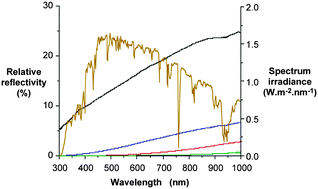Nanopore-type black silicon anti-reflection layers fabricated by a one-step silver-assisted chemical etching
Abstract
An effective and economical fabrication process for the synthesis of nanopore-type “black silicon”, that significantly decreases

* Corresponding authors
a Department of Chemical and Biomolecular Engineering, Rice University, Houston, Texas 77005, USA
b
Department of Chemistry, Rice University, Houston, Texas 77005, USA
E-mail:
arb@rice.edu
Tel: +1 713 348 5610
c Department of Mechanical Engineering and Materials Science, Rice University, Houston, TX 77005, USA
d College of Engineering, Swansea University, Singleton Park, Swansea SA2 8PP, Wales, UK
An effective and economical fabrication process for the synthesis of nanopore-type “black silicon”, that significantly decreases

 Please wait while we load your content...
Something went wrong. Try again?
Please wait while we load your content...
Something went wrong. Try again?
Y. Lu and A. R. Barron, Phys. Chem. Chem. Phys., 2013, 15, 9862 DOI: 10.1039/C3CP51835C
To request permission to reproduce material from this article, please go to the Copyright Clearance Center request page.
If you are an author contributing to an RSC publication, you do not need to request permission provided correct acknowledgement is given.
If you are the author of this article, you do not need to request permission to reproduce figures and diagrams provided correct acknowledgement is given. If you want to reproduce the whole article in a third-party publication (excluding your thesis/dissertation for which permission is not required) please go to the Copyright Clearance Center request page.
Read more about how to correctly acknowledge RSC content.
 Fetching data from CrossRef.
Fetching data from CrossRef.
This may take some time to load.
Loading related content
